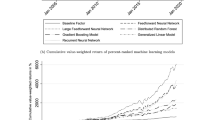Abstract
A recent strand in the literature emphasizes the role of news-based economic policy uncertainty (EPU) and equity market uncertainty (EMU) as drivers of oil price movements. Against this backdrop, this paper uses a kth-order nonparametric quantile causality test, to analyse whether EPU and EMU predict stock returns and volatility. Based on daily data covering the period of 2 January 1986 to 8 December 2014, we find that, for oil returns, EPU and EMU have strong predictive power over the entire distribution barring regions around the median, but for volatility, the predictability virtually covers the entire distribution, with some exceptions in the tails. In other words, predictability based on measures of uncertainty is asymmetric over the distribution of oil returns and its volatility.


Similar content being viewed by others
Notes
Measuring volatility of a series as squared returns, especially related to the oil markets has been discussed in detail by Lux et al., (forthcoming, 2016).
Further details are available at: http://www.policyuncertainty.com/us_daily.html.
Further details are available at:http://www.policyuncertainty.com/equity_uncert.html.
Not surprisingly, standard unit root tests reveal that oil price is a unit root process, while oil returns is stationary. On the other hand, EMU and EPU are found to be stationary. Complete details on the unit root tests are available upon request from the authors.
Often referred to as the fear index or the fear gauge, it represents one measure of the Market’s expectation of stock market volatility over the next 30-day period.
As indicated at: http://www.policyuncertainty.com/equity_uncert.html, the EMU exhibits a contemporaneous daily correlation with the VIX of over 0.3.
There was no evidence of predictability running from oil returns to either EPU or EMU even at 10 % level of significance. Complete details of these results are available upon request from the authors.
We obtained qualitatively similar results when we used oil returns and volatility based on the Brent crude price covering the period of 21 May 1987 to 8 December 2014. These results are available upon request from the authors.
Oil returns are found to cause the mean of EPU from quantiles 0.25 and above, while its volatility is predicted over the entire conditional distribution. For EMU, oil returns predict the mean over the entire conditional distribution. As far as volatility of EMU is concerned, oil returns predict it adequately except around the median and upper quantiles, i.e., beyond 0.80. Note that as it is difficult to interpret economically what part of the variance of the uncertainty is implied, we keep these results restricted only to this footnote. Complete details of these results are available upon request from the authors.
References
Andrews DWK (1993) Tests for parameter instability and structural change with unknown change point. Econometrica 61:821–856
Andrews DWK, Ploberger W (1994) Optimal tests when a nuisance parameter is present only under the alternative. Econometrica 62:1383–1414
Antonakakis N, Chatziantoniou I, Filis G (2014) Dynamic spillovers of oil price shocks and economic policy uncertainty. Energy Econ 44:433–447
Baker S, Bloom N, Davis S (2013) Measuring economic policy uncertainty. In: Chicago Booth Research Paper. No.13-02
Bai J, Perron P (2003a) Computation and analysis of multiple structural change models. J Appl Econom 6:72–78
Bekiros S, Gupta R, Paccagnini A (2015) Oil price forecastability and economic uncertainty. Econ Lett 132:125–128
Bloom N (2009) The impact of uncertainty shocks. Econometrica 77:623–685
Brock W, Dechert D, Scheinkman J, LeBaron B (1996) A test for independence based on the correlation dimension. Econom Rev 15:197–235
Colombo V (2013) Economic policy uncertainty in the US: Does it matter for the Euro area? Econ Lett 121:39–42
Hamilton JD (1983) Oil and the macroeconomy since World War II. J Polit Econ 91:228–248
Jeong K, Härdle WK, Song S (2012) A consistent nonparametric test for causality in quantile. Econom Theory 28:861–887
Jones PM, Olson E (2013) The time-varying correlation between uncertainty, output, and inflation: evidence from a DCC-GARCH model. Econ Lett 118:33–37
Kang W, Ratti RA (2013a) Structural oil price shocks and policy uncertainty. Econ Model 35:314–319
Kang W, Ratti RA (2013b) Oil shocks, policy uncertainty and stock market return. Int Financ Mark Inst Money 26:305–318
Kang W, Ratti RA, Yoon KH (2015) The impact of oil price shocks on the stock market return and volatility relationship. J Int Financ Mark Inst Money 34:41–54
Lux T, Segnon MK, Gupta R (2016) Forecasting crude oil price volatility and value-at-risk: evidence from historical and recent data. Energy Econ 56:117–133
Nishiyama Y, Hitomi K, Kawasaki Y, Jeong K (2011) A consistent nonparametric test for nonlinear causality: specification in time series regression. J Econom 165:112–127
Author information
Authors and Affiliations
Corresponding author
Additional information
We would like to thank two anonymous referees for many helpful comments. However, any remaining errors are solely ours.
Rights and permissions
About this article
Cite this article
Balcilar, M., Bekiros, S. & Gupta, R. The role of news-based uncertainty indices in predicting oil markets: a hybrid nonparametric quantile causality method. Empir Econ 53, 879–889 (2017). https://doi.org/10.1007/s00181-016-1150-0
Received:
Accepted:
Published:
Issue Date:
DOI: https://doi.org/10.1007/s00181-016-1150-0




